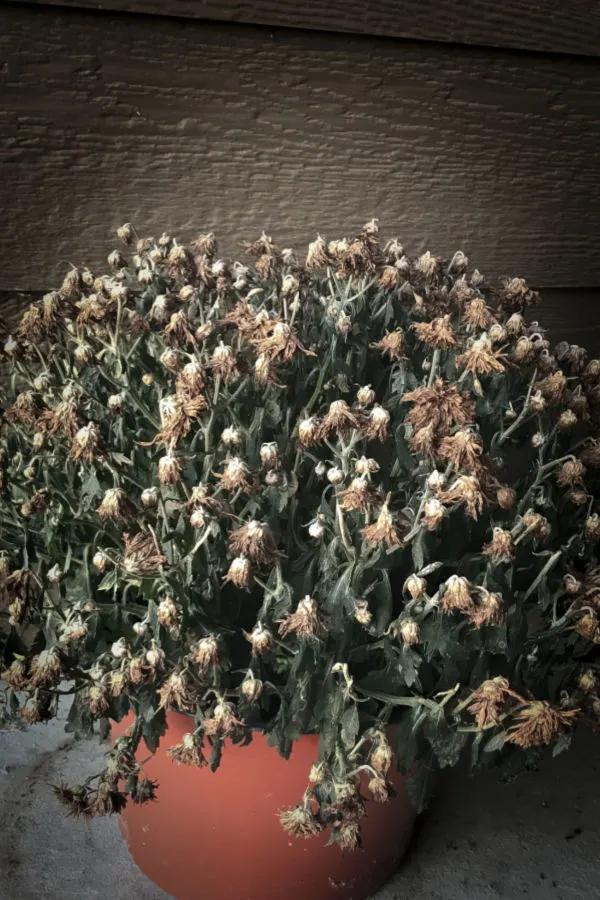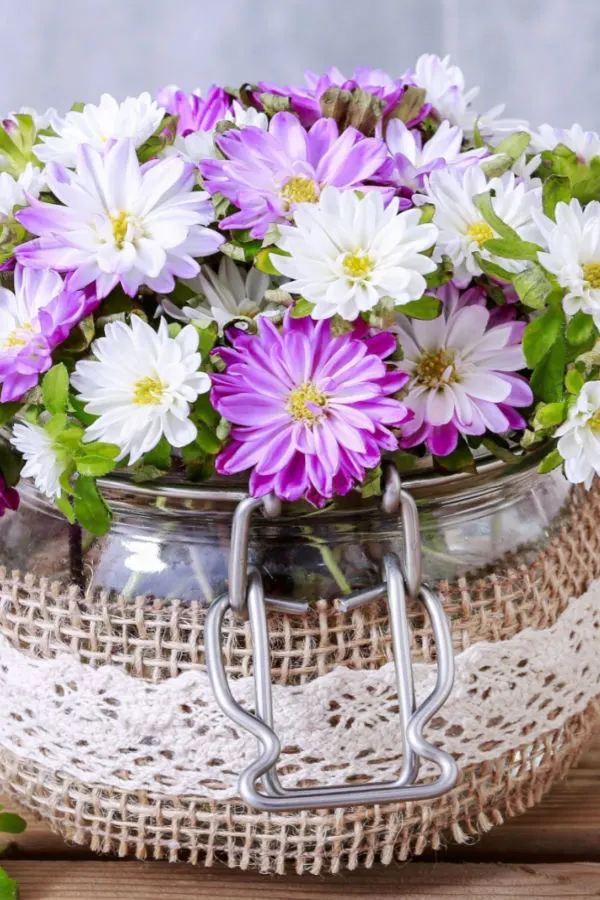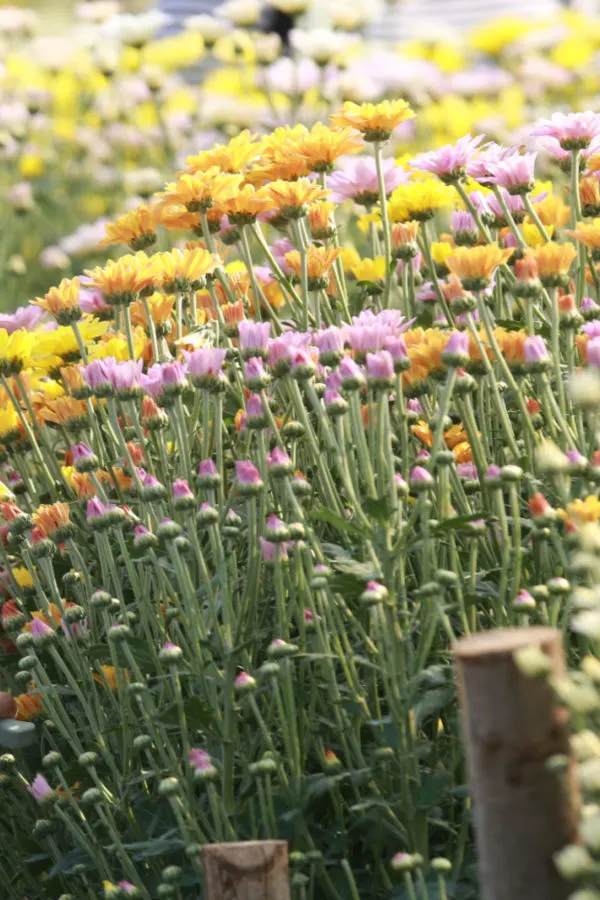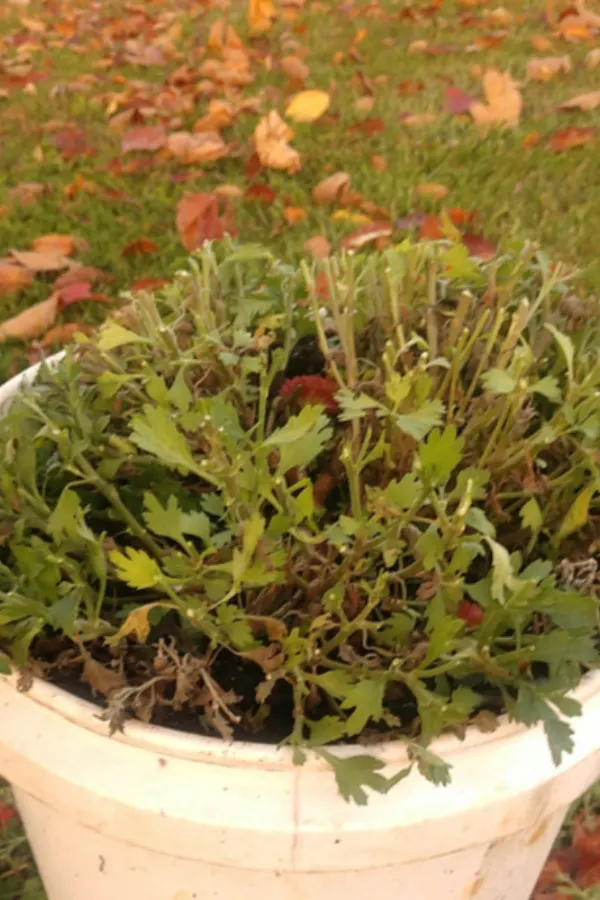Want to save those expensive mums you purchased this fall and keep them alive over winter to grow again next year? Not only is it possible, it just might be easier than you ever imagined!
Mums are the go-to plant for fall decorating. But can they ever be expensive! Especially when you consider that the large majority of mums that are purchased every fall end up being tossed out when their flowers fade away.
But it doesn’t have to be that way! A large majority of the mums that are sold are actually hardy varieties. Meaning, that with just a little bit of late season care, they can either be planted to grow in your landscape – or to be used to grow in pots and containers again next year for even bigger and better fall displays.

As a perennial, mums are quite easy to maintain from year to year. In fact, once they are established in the landscape, they are virtually maintenance free other than an occasional cutting back to keep blooms full and strong. They even have the added benefit of being deer and pest resistant.
With all of those advantage in mind, here are the simple secrets to saving your fading mums this fall for next year!
How To Save Mums
The most important factor of all for saving mums is to first make sure you have the right variety for saving. There are two types of mums that are sold for displays in the fall – garden mums and floral mums. And they are certainly different when it comes to their hardiness.
Garden mums are savable. They are a true perennial, and with a little fall preparation, can be kept alive to grow year after year. With a hardiness from growing zones 5 through 9, these are the mums you want to purchase and save.
Meanwhile, floral mums are not hardy in the least and cannot overwinter. No matter the care, they will not come back. With their shallow, tender roots, they simply do not have the root structure to withstand any cold at all. Once subjected to even the slightest of frost or frigid temperatures, they will quickly die out.

How To Tell What Kind Of A Mum You Have – How To Save Mums
So how do you know which type of mum you have? Usually, most mums will be sold with a label that will state if they are hardy mums or not. If your plants do not have a label, there are a few tricks to use that can help you figure out what type you have.
In general, tiny or very small mums that grow in small, shallow containers tend to be floral varieties. Floral mums also usually have much smaller stems, leaf sets and blooms than their hardy counterparts. If you do have floral mums, once they fade away, it’s time to put them in the compost pile.
Meanwhile, larger mums in larger pots most often tend to be savable hardy garden mums. It’s not a perfect science for sure, but if your mums are in pots that are at least 6 inches in diameter, and 4 to 6 inches deep – and they have large blooms and leaf sets – they are most likely hardy mums. And of course, that means you can save them!
For the record, the good news is that the large majority of mums that sell in stores each fall tend to be hardy mums. They simply have more flower power and size, and are more attractive to customers.
How To Save Hardy Garden Mums For Next Year
Now let’s take a look at how to easily save hardy garden mums! There are several methods for overwintering, and selecting the best one will all depend on how your mums are currently growing. We will begin with the most popular of all, potted mums.
Saving Potted Mums
When saving potted mums, the first key is to never let them endure a freeze in their pot or container. Always move your mums to safety indoors when extremely low temperatures or a freeze is in the forecast. Mums can survive light frosts and cold fairly easy, but a hard freeze can and usually will kill roots in pots permanently.
When your mums flowers begin to fade, or when the temperatures simply become too cold in late fall, it is time to move your plants to safety for good. For mums in pots in late fall, that means getting them indoors to survive their first winter.
Although you can plant mums directly into the ground in late summer or early fall, waiting until late in the season to do this usually will result in a mum’s failure.
Unfortunately, mums planted back into the ground in late fall have little chance for survival. Even with heavy mulching, they simply don’t have time to establish in the soil for protection. When that happens, their roots freeze out fairly easily.
Bringing Mums Indoors – How To Save Mums & Keep Them Alive Over Winter
There are a few simple steps you should take before bringing your mums indoors. First, cut the mum back a few inches above the potted soil line. This will take it down mainly to its stems and a few small leaves, but don’t worry, it will be just fine!
If the soil is dry to the touch, lightly water the plant, being careful not to saturate it. Too much water over the winter can cause the plant’s roots to rot out. Next, for best success, store in a cool corner of the basement or a semi-heated or insulated garage.
The goal is to allow the plant to go dormant without freezing. Temperatures that range from 45° to 60° are ideal to keep it dormant but alive. You will want to water them from time to time through the winter, but only lightly every few weeks. Again, always being careful not to saturate the soil.
Planted Mums – How To Save Mums & Keep Them Alive Over Winter
If you have mums growing in the landscape, or if you planted your mums in early fall for a display, you can overwinter them in place outdoors. As long as the mums have at least four to six weeks in the ground before the first frost, the roots have most likely set.
For mums that will stay in the landscape, its foliage should kept in tact. By leaving the leaves and stems in place, it helps to provide extra protection for the mums through winter. In addition to leaving the foliage in place, apply a thick layer (4 inches) of mulch around the plant to help insulate the roots as well.
What To Do With Potted Mums In The Spring – How To Save Mums & Keep Them Alive Over Winter
When early spring arrives, it’s time to start getting your mums ready for outdoor life again! The easiest method to keep mums growing is to simply plant them directly into the landscape. Mums are a beautiful perennial plant, and provide beautiful greenery in flowerbeds in early spring and summer. But as you will see below, you can repot them too.
When the threat of frost has passed, you can plant them outdoors as you would any other perennial. For overly large mums, this is also the perfect time to split and divide them to create new plants. Simply cut apart into equal sections with a sharp knife or shovel and replant.

Be sure to keep plants well watered for the first few weeks to help establish them in the soil. Mums prefer rich, fertile and well draining soil, so adding compost when planting into flowerbeds will help them re-establish much more successfully.
Repotting Mums In The Spring
If you want to grow your mums in a pot or container again, you will need to re-pot them with new potting soil. This allows for plenty of nutrients for the new season. Unfortunately, if left in the same soil, the plants will struggle to regain their strength.
If the roots have grown too big for the same size pot, (this will usually be the case) you will need to replant into a larger vessel, or split and divide to allow room for root growth. Like with all container and basket plants, wait until the threat of frost has passed to divide and transplant.
Summer Care – How To Save Mums & Keep Them Alive Over Winter
When growing for a full season outdoors (spring to fall), you will need to trim back your plants in mid summer if you want fall blooms. Mums will usually bloom in late summer if left alone, but to have stronger and tighter blooms, and to have fall blooms, you will need to prune them back in late June or early July.

To do this, either pinch or cut off the blooms in the middle of summer. This allows plenty of time for the plant to regrow tighter foliage and bloom sets. It also delays the blooming until fall, when most gardeners want their mums to bloom for a fall display.
Mums that grow a full season in the landscape will be fine to overwinter in place. However, if you dig them up to pot them, you will once again need to overwinter indoors until the following spring. Here is to overwintering your garden mums and keeping them alive over winter to grow again! Happy Gardening – Jim and Mary
Jim and Mary Competti have been writing gardening, DIY and recipe articles and books for over 15 years from their 46 acre Ohio farm. The two are frequent speakers on all things gardening and love to travel in their spare time.
As always, feel free to email us at thefarm@owgarden.com with comments, questions, or to simply say hello! You can sign up for our free email list in the subscribe now box in the middle of this article. Follow us on Facebook here : OWG Facebook. This article may contain affiliate links.

